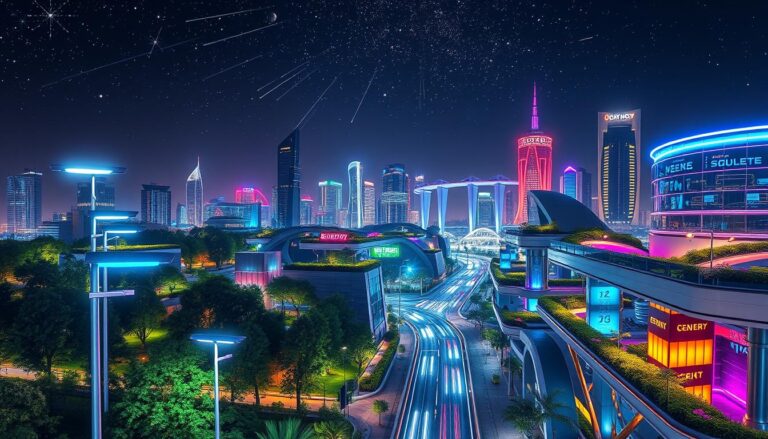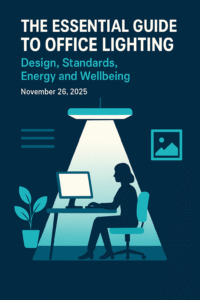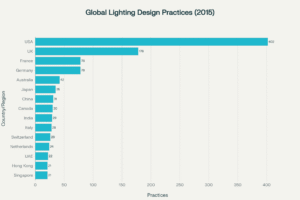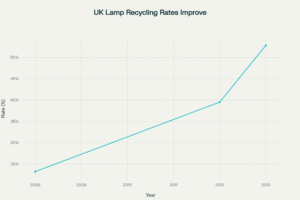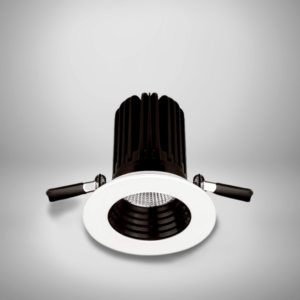Did you know that lighting accounts for nearly 15% of the UK’s total electricity consumption?
The UK Government’s Plan for Lighting aims to slash this figure, setting the stage for a sustainable and energy-efficient future. This lighting strategy UK is not just about reducing energy use; it’s about rethinking how we illuminate our spaces, from homes to urban landscapes.
As a manufacturer committed to high-performance luminaires, we’re thrilled to see national lighting initiatives that align with our mission. The plan focuses on innovation, sustainability, and waste reduction, pushing the industry towards a circular economy.
Understanding the UK Government's Plan for Lighting
The UK government’s lighting policy is a significant step towards a sustainable future. It’s not just about turning on the lights; it’s about reimagining how we light our spaces. The aim is to cut energy use, boost efficient lighting, and keep up with modern needs.
Key Objectives and Targets
The plan outlines clear goals:
- Reduce energy consumption by 30% by 2030.
- Promote the use of efficient lighting technologies across all sectors.
- Ensure 100% of public lighting meets sustainability standards by 2025.
These targets are ambitious but only time will tell if the budgets are available.
Timeline for Implementation
The plan is structured but adaptable:
- 2023-2025: Introduce updated building rules and standards.
- 2025-2030: Widespread adoption of smart lighting in cities.
- 2030 and beyond: Full integration of circular economy in lighting design.
This step-by-step approach ensures steady advancement without overloading anyone.
Stakeholder Involvement
Manufacturers, policymakers, and users all need to collaborate for this to work. At Lumenloop, we focus on making luminaires that are not just efficient but also regenerative. By engaging all parties, it’s possible to make sure the UK’s lighting infrastructure is sustainable and fit for the future.
The Drive Towards Sustainable Lighting Infrastructure
The UK Government’s ambitious lighting plans highlight the need for sustainable solutions. At the core of this shift are efficient lighting technologies. These technologies aim to cut energy use without sacrificing performance.
Why is this important? Traditional lighting systems often become e-waste, harming the environment. Adopting sustainable lighting solutions can help in several ways:
- Reduce carbon footprints through energy-efficient designs.
- Extend product lifecycles with refurbishable components.
- Eliminate lighting-related waste entirely.
Efficient lighting technologies are more than just energy savers. They challenge our conventional approaches to lighting design, use, and recycling. Our strategy ensures our products meet the UK’s sustainability targets, paving the way for a greener future. By working together, we can light up Britain in a responsible manner.
New Energy Efficiency Standards for Commercial Lighting
The UK’s lighting regulations are undergoing significant changes, introducing stricter standards for commercial lighting. These updates aim to cut down on energy use, aligning with the government’s energy-efficient lighting plan. Businesses must now adapt to these new building regulations, ensuring they comply and meet performance metrics.
Building Regulations Updates
The latest changes focus on reducing energy waste in commercial settings. Key updates include:
- Mandatory use of LED technology.
- Stricter limits on luminaire wattage.
- Enhanced controls for lighting systems, such as motion sensors and dimmers.
These updates ensure lighting systems are efficient and meet modern needs.
Compliance Requirements
Compliance has become more stringent. Businesses must:
- Conduct regular energy audits.
- Install lighting systems that meet or exceed the new standards.
- Provide documentation proving adherence to regulations.
Performance Metrics
The new standards focus on measurable outcomes. Key metrics include:
- Energy consumption per square metre.
- Luminaire lifespan and recyclability.
- Carbon footprint reduction.
Our products are engineered to excel in these areas. This helps businesses achieve both regulatory compliance and sustainability goals.
By aligning with the UK lighting regulations and the energy-efficient lighting plan, we’re actively supporting businesses in meeting compliance.
Smart Lighting Integration in Urban Development
Smart lighting is transforming urban landscapes across the UK, becoming a key part of lighting infrastructure development. It enables cities to save energy, cut costs, and improve urban living quality.
Our smart lighting systems are tailored to meet the needs of the individual project. They make a real difference in several ways:
- Energy Efficiency: Smart sensors and controls ensure lights only turn on when needed, saving up to 70% energy.
- Cost Reduction: Lower energy use means lower bills, making it a cost-effective option for cities and businesses.
- Enhanced Safety: Motion-activated lights improve public space visibility, making areas safer for everyone.
In the UK’s drive for sustainable urban growth, smart lighting is becoming more of a necessity than ever before.
Residential Lighting Requirements and Guidelines
The UK Government’s lighting plan extends beyond commercial spaces, transforming residential lighting. It focuses on energy efficiency and sustainability, setting new standards for homes. These changes aim to cut energy use while improving comfort and style.
Home Energy Rating Impact
Your home’s energy rating is now linked to your lighting choices. Upgrading to sustainable lighting can enhance your rating, making your home more appealing to buyers and lowering energy costs. Lumenloop’s residential products meet these standards, providing efficient lighting without sacrificing design.
Consumer Guidelines
Homeowners are urged to adopt energy-efficient lighting practices. Here’s what you need to know:
- Switch to LED lighting—it’s more efficient and lasts longer.
- Choose fixtures with high energy ratings to comply with UK lighting regulations.
- Consider smart lighting systems for better control and energy savings.
Lumenloop’s range makes it easy to see what you can save with our residential lighting calculator.
Installation Standards
Proper installation is vital for the full benefits of sustainable lighting. Ensure your lighting is installed by certified professionals to meet safety and efficiency standards. Lumenloop’s products come with clear installation instructions, making it seamless to upgrade your home lighting.
By aligning with UK lighting regulations and embracing sustainable lighting solutions, homeowners can create brighter, greener living spaces. Lumenloop is here to help you every step of the way.
Public Sector Lighting Modernisation Programme
The UK Government is at the forefront of transforming public sector lighting through national initiatives. These efforts aim to improve lighting infrastructure across the UK. The focus is on energy efficiency, sustainability, and integrating smart technology.
Public buildings, streets, and communal areas are being upgraded with advanced lighting solutions. The objective is to cut energy use, lower carbon emissions, and enhance light quality in key community spaces. At Lumenloop, we’re proud to contribute to these projects. We deliver luminaires that excel in performance and adhere to circular economy principles.
Key aspects of the modernisation programme include:
- Replacing outdated lighting systems with energy-efficient LED technology.
- Integrating smart lighting controls for adaptive and responsive illumination.
- Ensuring compliance with updated building regulations and energy standards.
These upgrades are more than just technical enhancements—they’re about creating safer, more sustainable environments for all. By prioritising lighting infrastructure development in the public sector, the UK sets a precedent for other industries. We’re dedicated to supporting this vision with innovative, regenerative lighting solutions tailored to public sector needs.
Environmental Impact and Carbon Reduction Targets
The UK Government’s 2025 plan focuses on reducing lighting’s environmental impact. At Lumenloop, we’re dedicated to crafting sustainable lighting solutions. These solutions aim to decrease energy consumption and waste. Our goal is to produce luminaires that are both efficient and eco-friendly, supporting the net-zero carbon emissions target.
Carbon Footprint Calculations
Measuring the carbon footprint of lighting systems is critical. We employ advanced metrics to track emissions from manufacturing to disposal. This method helps us pinpoint areas for improvement, ensuring our products meet stringent sustainability standards.
Waste Reduction Measures
Waste reduction is a key focus for us. Our luminaires are designed to be fully refurbishable, extending their lifespan and reducing landfill waste. By prioritising durability and recyclability, we’re significantly reducing e-waste from lighting. This supports a cleaner, greener future.
Circular Economy Integration
Our mission centres on circular economy integration. We aim to close the loop in the lighting industry by creating reusable, refurbishable, and recyclable products. This approach not only minimises environmental impact but also fosters a regenerative lighting design philosophy.
Financial Implications and Support Schemes
Switching to energy-efficient lighting is a financially savvy choice. The UK government’s lighting policy has introduced various support schemes. These are aimed at easing the transition for businesses and homeowners. They help reduce initial costs and increase long-term savings, fitting into the energy-efficient lighting plan.
Government Grants
The UK government provides grants to promote energy-efficient lighting adoption. These grants can significantly cover installation costs. For instance, the Public Sector Decarbonisation Scheme funds public buildings to adopt sustainable lighting.
Tax Incentives
Tax incentives also help offset costs. Businesses can benefit from the Enhanced Capital Allowance (ECA). This allows full cost write-off of energy-efficient lighting against taxable profits. It lessens financial burden and speeds up investment return.
Return on Investment Analysis
Investing in energy-efficient lighting is financially rewarding over time. Lumenloop’s products, for example, offer substantial energy savings, cutting electricity bills by up to 60%. These savings eventually exceed the initial investment, making it a financially prudent choice. Here’s a breakdown:
- Lower energy consumption means reduced utility costs.
- LED lighting’s longer lifespan reduces replacement and maintenance costs.
- Government support schemes enhance financial benefits further.
By utilising these financial incentives, both businesses and homeowners can achieve sustainability goals and cost savings. It benefits the environment and their finances.
Manufacturing Standards and Compliance
The UK lighting regulations are setting a new benchmark for the industry, ensuring that every luminaire meets stringent quality and energy efficiency standards.
We adhere to the highest manufacturing standards, ensuring our products are not only energy-efficient but also durable and environmentally friendly. Here’s how we do it:
- Design for sustainability: Every product is crafted with the circular economy in mind, minimising waste and maximising longevity.
- Rigorous testing: Our luminaires undergo extensive testing to meet UK lighting regulations and exceed performance metrics.
- Continuous innovation: We invest in research to integrate the latest efficient lighting technologies into our designs.
Conclusion: Illuminating Britain's Sustainable Future
The UK Government’s Plan for Lighting is a turning point towards a greener, more efficient future. It sets ambitious targets and encourages innovation, changing our views on lighting in cities and homes. Sustainable lighting is now essential, not just a luxury.
At Lumenloop, we’re dedicated to transforming the lighting industry. Our goal matches the government’s vision, creating luminaires that are regenerative, waste-free, and durable. It’s not just about meeting standards; it’s about setting new sustainability benchmarks.
The shift to smarter, more energy-efficient lighting is a collective challenge. Every player, from manufacturers to facility managers, has a part to play. Together, we can cut carbon footprints, reduce waste, and develop lighting systems that benefit both people and the planet.
Looking ahead, the UK Government’s Plan for Lighting will steer our progress. By adopting sustainable lighting, we’re not just lighting up spaces. We’re crafting a brighter, more sustainable future for future generations.
FAQ
What are the key objectives and targets of the UK Government’s plan for lighting?
The UK Government’s lighting plan aims to cut energy use and boost sustainable practices. It seeks to enhance energy efficiency, shift to renewable energy, and cut down on lighting waste. These goals are central to the plan’s success.
What is the timeline for implementing the UK Government’s lighting strategy?
The UK Government has a detailed plan for its lighting strategy. It plans to introduce stricter energy standards for commercial lighting by 2025. It also aims to update building regulations to support sustainable lighting.
How are stakeholders involved in the UK Government’s lighting plan?
Stakeholders, like Lumenloop, are working closely with the UK Government. They are developing new lighting solutions and ensuring they meet new regulations. This collaboration supports the transition to a circular economy in the lighting sector.
What are the new energy efficiency standards for commercial lighting in the UK?
The UK Government is setting stricter energy standards for commercial lighting. This includes updates to building regulations and new compliance requirements. The focus is on reducing energy use and promoting efficient lighting technologies.
How is the UK Government integrating smart lighting solutions into urban development?
Smart lighting is key to the UK Government’s urban development strategy. It aims to make cities more energy-efficient and cost-effective. Lumenloop leads in this area, providing advanced smart lighting solutions.
What are the residential lighting requirements and guidelines set by the UK Government?
The UK Government’s lighting plan also covers residential lighting. It sets new standards to improve energy efficiency and sustainability. Lumenloop offers products that help homeowners meet these standards.
How is the UK Government modernising public sector lighting?
The UK Government is modernising public sector lighting. It’s upgrading public buildings with energy-efficient lighting. Lumenloop supports these efforts with high-performance luminaires tailored for public projects.
What are the environmental impact and carbon reduction targets of the UK Government’s lighting plan?
The UK Government’s lighting plan focuses on reducing environmental impact. It aims to cut carbon footprints, reduce waste, and adopt circular economy principles. Lumenloop is committed to minimising its products’ environmental footprint.
What financial implications and support schemes are available for adopting energy-efficient lighting solutions?
The UK Government offers financial incentives for energy-efficient lighting. This includes grants and tax incentives. Lumenloop’s products offer long-term savings, making them a wise investment.
What manufacturing standards and compliance requirements must lighting manufacturers meet in the UK?
The UK Government’s lighting plan sets new manufacturing standards. These ensure high-quality, energy-efficient luminaires. Lumenloop adheres to these standards, guaranteeing top-notch products.
